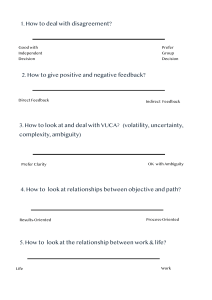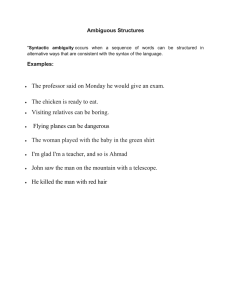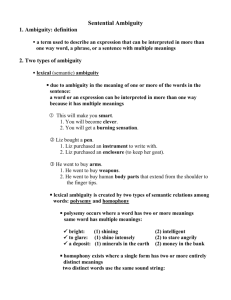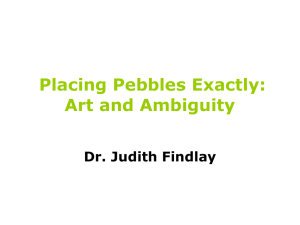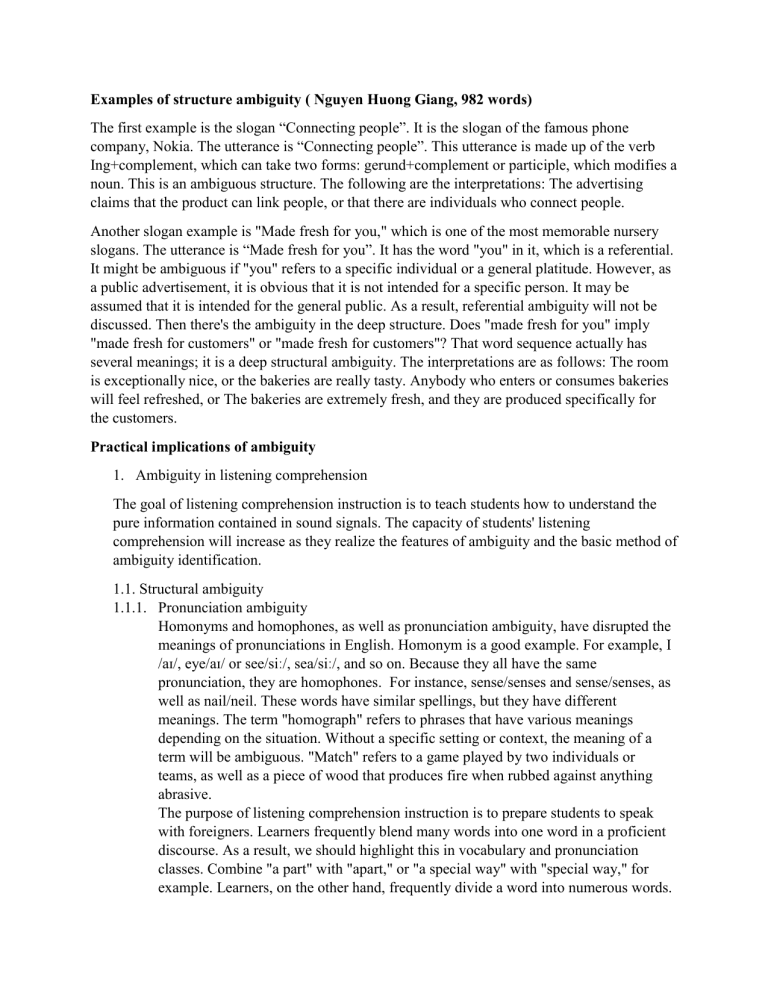
Examples of structure ambiguity ( Nguyen Huong Giang, 982 words) The first example is the slogan “Connecting people”. It is the slogan of the famous phone company, Nokia. The utterance is “Connecting people”. This utterance is made up of the verb Ing+complement, which can take two forms: gerund+complement or participle, which modifies a noun. This is an ambiguous structure. The following are the interpretations: The advertising claims that the product can link people, or that there are individuals who connect people. Another slogan example is "Made fresh for you," which is one of the most memorable nursery slogans. The utterance is “Made fresh for you”. It has the word "you" in it, which is a referential. It might be ambiguous if "you" refers to a specific individual or a general platitude. However, as a public advertisement, it is obvious that it is not intended for a specific person. It may be assumed that it is intended for the general public. As a result, referential ambiguity will not be discussed. Then there's the ambiguity in the deep structure. Does "made fresh for you" imply "made fresh for customers" or "made fresh for customers"? That word sequence actually has several meanings; it is a deep structural ambiguity. The interpretations are as follows: The room is exceptionally nice, or the bakeries are really tasty. Anybody who enters or consumes bakeries will feel refreshed, or The bakeries are extremely fresh, and they are produced specifically for the customers. Practical implications of ambiguity 1. Ambiguity in listening comprehension The goal of listening comprehension instruction is to teach students how to understand the pure information contained in sound signals. The capacity of students' listening comprehension will increase as they realize the features of ambiguity and the basic method of ambiguity identification. 1.1. Structural ambiguity 1.1.1. Pronunciation ambiguity Homonyms and homophones, as well as pronunciation ambiguity, have disrupted the meanings of pronunciations in English. Homonym is a good example. For example, I /aɪ/, eye/aɪ/ or see/siː/, sea/siː/, and so on. Because they all have the same pronunciation, they are homophones. For instance, sense/senses and sense/senses, as well as nail/neil. These words have similar spellings, but they have different meanings. The term "homograph" refers to phrases that have various meanings depending on the situation. Without a specific setting or context, the meaning of a term will be ambiguous. "Match" refers to a game played by two individuals or teams, as well as a piece of wood that produces fire when rubbed against anything abrasive. The purpose of listening comprehension instruction is to prepare students to speak with foreigners. Learners frequently blend many words into one word in a proficient discourse. As a result, we should highlight this in vocabulary and pronunciation classes. Combine "a part" with "apart," or "a special way" with "special way," for example. Learners, on the other hand, frequently divide a word into numerous words. Another example is separating “underground” into “ender of the ground” or separating “especially” into “a special” and so on. In daily conversation, the listener can understand the meaning of the talker, even though the pronunciation of certain words is ambiguous. In some cases, homonyms will cause thinking and listening to comprehension to be suspended. 1.1.2. Words Ambiguity "Words do not have meaning, people have meanings for them," linguistic Eric Partridge explained. It indicates that the ambiguity and diversity of word meanings is an important aspect of communication. Words can have multiple meanings or even contradictory meanings depending on the situation. For instance: “It is a wet summer”. “Wet” means “rainy” in this context. “He is wet through”. The term “wet” refers to being completely submerged in a liquid. “He is all wet”. The term "wet" refers to the definition of a blunder in this context. Learners may correctly hear the words, but they may not understand the exact meaning of the words because they have not mastered enough meanings of the words. “People will give a word some different meanings under different context,” said Robert A.Hall. When it comes to listening comprehension, learners need to examine the material extremely thoroughly in order to get the whole meaning. 1.1.3. Ambiguity in the sentence’s structure. In fluent speech, carelessness obscures terms like “a, an, the, of, in, at, or will”. When these words are said, the speaker's voice is muted and the discourse is so quickly that they are omitted. The word “the” will be omitted. Such as: A : He went to prison yesterday. B: He went to the prison yesterday. In sentence A, the person was a prisoner. The person in sentence B has just returned from a visit to a prison. 1.2.The basic methods of distinguishing ambiguity The English language should be taught in the same way as other languages. The logic of people's thoughts governs their understanding of ambiguity. That is the key to knowing pure information. It's a good way to learn to do it. 1.2.1. Griping the additional things of sounds. In the absence of communication, one can convey his meaning by pausing, altering his tone, mood, and other means, such as laughing, shouting, moaning, sighing, and so on. All of them are language's extra features, and they're crucial in identifying ambiguity in listening comprehension. 1.2.2. Identify the context As the context shifts, the meaning of the statement shifts as well. The term "context" refers to the situation in which communication is taking place. For example: “It is a square meal”. Because of the meal in the phrase, the word "square" here refers to a generous form, not a shape with four straight sides of equal length and four right angles. The shape of language depends on context and variations usually cling to a given context. The talker employs correct speech in a given context to arrange his speech to correspond with a specific context and social background. We should distinguish context positively in order to reduce misunderstanding of the current information's ambiguity. References Lebrun, Y. (2018, February 5). Partridge (Eric). 1. Origins. 2. A Dictionary of Slang. https://www.persee.fr/doc/rbph_0035-0818_1962_num_40_1_2405_t1_0128_0000_3 Moulaei, A. (2017). Investigating the Relationship between Tolerance of Ambiguity, Individual Characteristics and Listening Comprehension Ability among Iranian EFL Learners. International Journal of English Linguistics, 6(7), 185. https://doi.org/10.5539/ijel.v6n7p185
